Pagan Pride Parade at Beltane Bash
Holborn, London. Sunday 30 May 2010
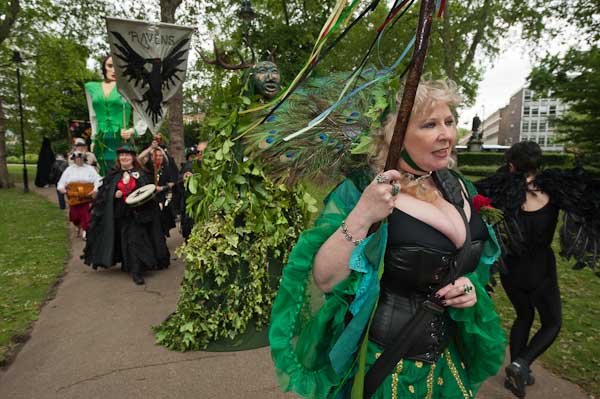
Jeanette, carrying the stang, leads the procession into Russell Square
more pictures
Pagans of all persuasions from across Britain gathered in London and held a
parade to celebrate their faith, dancing in the fountains at Russell Square
and in the British Museum courtyard.
The Pagan Pride Parade is a part of a two day celebration of Beltane,
a traditional festival, particularly in Ireland, which marked the start of
the summer, when cows and sheep were moved to summer pastures on higher ground.
Midway between the Spring Equinox and Summer Solstice it was usually celebrated
in early or mid-May. Various rituals were carried out which it was hoped would
lead to a good growing season and a fruitful harvest. Originally a Gaelic
festival, it is clamed to be still celebrated in some rural areas, and similar
festivals were also found among the Celts.
Contemporary pagan movements have revived the celebration of Beltane and
the Beltane Bash, held at the late May bank holiday in London is a two day
festival that brings together, according to it's web site, "Pagans
of all traditions, whether they follow the Witch, Wiccan, Hedge witch, Druid,
Heathen, Asatru, Shaman, Egyptian tradition." No one seems clear
when the first Pagan Pride parade in London was held, but it seems to have
been around ten years ago; I first photographed it
in 2004, and have done so several times since.
Reliable figures are hard to come by and some put the number of Pagans in
the UK as high as 250,000. At the 2001 census there were 42,262 who stated
that they were Pagan, which they claim makes paganism the seventh largest
religion in the country. Others might feel that the differences between the
different groups are so wide it makes little sense to regard them as a single
religion.
The parade gathered on Sunday morning in Red Lion Square, with the Pentacle
drummers and several 'giants' including the Morrighan - a Celtic War goddess,
accompanied by ravens. Leading the march was organiser Jeanette Ellis, a traditional
witch and writer and lecturer on witchcraft (she also makes pagan jewellery)
from Walthamstow carrying the stang, a pole decorated with coloured streamers,
antlers and on its tip a model stag, and behind her were the Jack in the Green
and banners.
Around a couple of hundred people followed in the parade to the fountain
in Russell Square, where people danced holding hands at first around the circle
of jets and then through them as the drummers played and the rest of the parade,
along with a number of spectators including some rather suprised tourists,
watched.
From there the parade went off to the courtyard in front of the British Museum
where again some danced and others rested. From there the parade returned
to Red Lion Square to continue with the two days of the Beltane Bash in private.
more pictures
Brian & Barbara Arrested
Parliament Square, London. Tuesday 25 May 2010
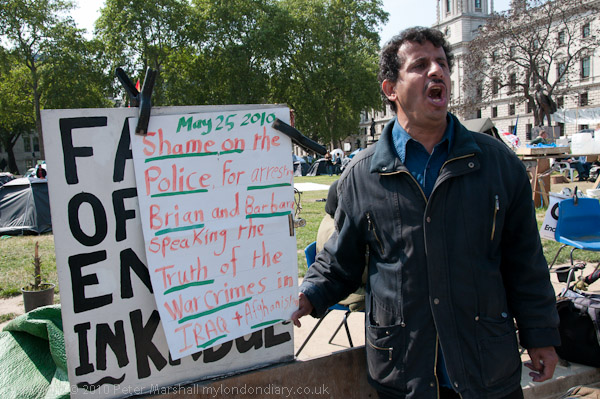
'Shame on the Police for Arresting Brian and Barbara' - but I was far too
late to see it.
more pictures
Unfortunately I wasn't in Parliament Square when Brian and Barbara were arrested
by police early in the morning. I got the news when I arrived there rather
later in the day on my way to a meeting. There had been some other demonstrations
scheduled to take place but everything was over by the time I got there.
But I was able to talk to some of those who had seen the arrest, and later
saw the video. It looked as if the police had decided they would make an arrest
to get them away from the square when the Queen arrived to read her speech
in Parliament and where looking for the slightest pretext.
It was good to find that there had been photographers present, and to see
the cover of the London evening newspaper which gave rather more prominence
to Brian being roughly handled by police than to the Queen. And even though
the story contained a lot of silly comment it did also give a decent idea
of exactly what had happened - including the unnecessarily rough treatment
given to Brian by some officers who obviously enjoy that aspect of their job
and are not kept properly under control.
more pictures
Democracy Camp Continues
Parliament Square, London. Saturday 22 May 2010
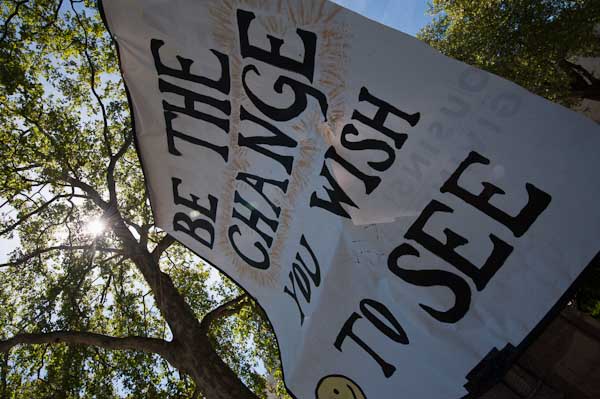
'Be the Change You Wish to See'
more pictures
Just a few pictures from Parliament Square, which I walked through several
times today. The Democracy Camp - or as the Parliament Square Peace
Campagn refer to it, the Police Camp - is still there, despite some
huffing and puffing from Boris and others, although there wasn't a lot happening
when I was around.
more pictures
EDL In Patriot March in Central London
Westminster, London. Saturday 22 May 2010
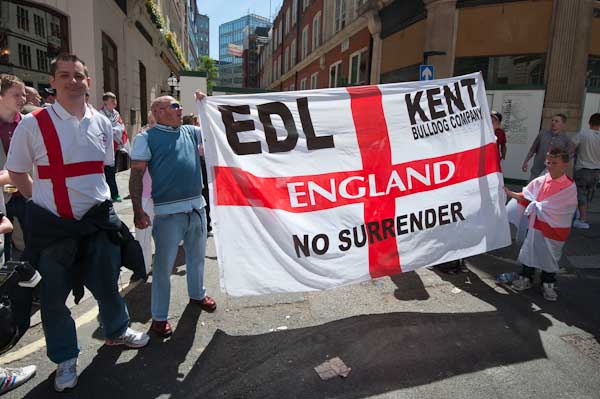
EDL Kent Bulldog Company England Flag says 'No Surrender'
more pictures
The English Defence League marched through London today, paying respect to
the war dead at the Cenotaph in Whitehall before a short rally. There none
of the violence and counter demonstrations that have occurred at some previous
EDL events around the country. Although not officially an EDL event, the majority
of those taking part in what was described as a 'Patriot March to Challenge
Parliament' organised by 'British Citizens Against Muslim Extremists' were
from the EDL.
A couple of hundred people, including quite a few families with women and
children, marched through the capital, many carrying St George's flags. I
met them outside a pub in Westminster from where the march started, where
there was a considerable amount of chanting in defence of some English values
and singing of the first verse of the National Anthem.
When one man began a chant about Allah, he was immediately stopped by the
stewards who made it clear both that the EDL was against such racist sentiments
and also that the police had told them they would stop the march taking place
if there were such racist chants. And when one of the demonstrators looked
likely to attack one of the press photographers he was quickly led away and
calmed down.
There are many things that the EDL opposes that many of use would also oppose,
including any imposition of Sharia Law in this country. But although people
kept telling us that the EDL was not racist, there were still chants about
Muslim bombers that many of us find unacceptable. The vast majority of Muslims
in the UK are also opposed to the bombers and we all should also be equally
opposed to other bombers - including those from the extreme right.
It's just wrong to stigmatise a whole community for the action of a minute
number of extremists, whose actions are thought by most to be inconsistent
with Islam. The EDL keep saying that they have nothing against those Muslims
who wish to become integrated into the British way of life, and they should
make sure that their slogans and chants reflect this.
Unlike on other occasions, the UAF and other antifascists had chosen to ignore
this event and there was no counter-demonstration. The march set off noisily,
but as it turned into Whitehall and approached the Cenotaph it became a silent
tribute to British troops, which was followed by applause, with the chanting
resuming as they came past Downing St and on to Trafalgar Square. They continued
along to Waterloo Place where the march ended.
Here I photographed a young man on the rally with a disturbing story about
police harassment. He had been stopped on the street by police for wearing
a t-shirt which combined an image of a St George's Cross with a skull and
told that wearing was an offence under the Public Order act, and that he would
be cautioned unless he removed it. He was wearing the same t-shirt today and
it was hard to see any possible justification for the police action. I also
heard stories about people being threatened by police for wearing England
shirts and being refused entry to pubs, - said to be an urban myth, although
many pubs do have a blanket 'no-sportswear' entry policy.
After a short break there was then a rally, addressed by a man who announced
to cheers that he was the first EDL local councillor following the recent
local elections. Again he stressed that the EDL was not a racist organisation
but one that wanted to promote traditional British values and support the
expression and valuation of our heritage.
Many of us who are not members of the EDL would like to see a proper celebration
of traditional British culture and would certainly support the wider use of
the English and other British flags and the proper celebration of our national
Saints Days. And while parts of our history have involved the exploitation
of other cultures, there are also many aspects of which we can justly be proud,
particularly for example in the areas of science and technology. We can (and
should) be proud of our heritage but not like this.
At this point a small minority of those present decided to prevent photographers,
including myself from taking pictures. I protested to a couple of the stewards
and after talking with me for some minutes one of them accompanied me and
made sure I was not further prevented from reporting. By then I felt I had
probably taken all the pictures I needed, but it was an indication that some
at least of the EDL still need to become more open in their relations with
the media and in the respect for our civil rights.
more pictures
Save BBC 6Music & Asian Network
Broadcasting House, Portland Place London. Saturday 22 May 2010
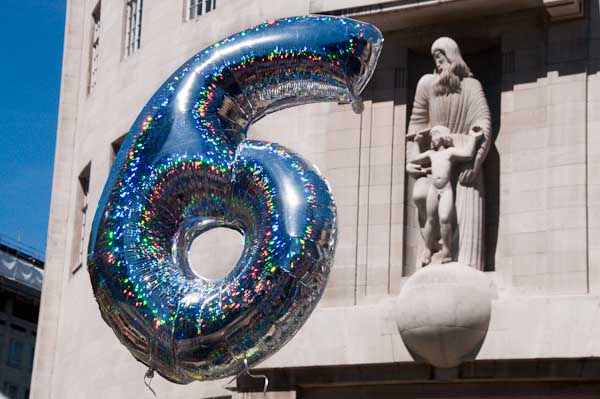
6 Balloon and Eric Gill's famous statue of Prospero
and Ariel above the doorway of Broadcasting House
more pictures
More than 500 people came to the BBC in London to support 6 Music, certainly
the best of the BBC's popular music programmes which, along with the Asian
Network, is under threat of closure.
Listening figures for 6 Music are, as was pointed out, difficult to obtain,
as the station is not even listed in the official method for collecting audience
figures and official estimates are almost certainly a considerable underestimate.
But current estimates are of over a million listeners each week, and the campaign
against closure has seen a fairly dramatic rise, with more people discovering
the station.
Radio 6 is perhaps the prime example currently of the BBC meeting its charter
obligations and providing a real service that is not mirrored by commercial
offerings. It would be hard to justify most of its other channels in that
way, much though we may appreciate the quality and professionalism of some
(though very much not all) of them. It isn't a station I listen too much -
it isn't available on most of the radios I use which doesn't help, but it's
certainly something I think should be there. If the BBC feel a need to get
rid of something, I certainly wouldn't miss BBC1, Radio 1 or the Archers!
It was, as the man fronting the show (like other presenters from the station
he made clear he was present as a listener and licence fee payer rather than
in his role as a presenter) said, a very middle class protest, with some exceedingly
polite slogans. But there are some very strong opionions behind these, and
it seems that the campaign has a very good chance of success.
The protest also pointed out some of the problems of running events with
live music, particularly over the need to get police permission. Liberal peer
Lord Clement-Jones hopes that his bill, or the recent proposals by the Culture
Media and Sport committee which wanted to bring back the old 'two in a bar'
rule and allow unamplified performances by one or two musicians as well as
giving exemptions for venues seating less than 200 people. At the moment we
have the ludicrous situation where big screen broadcast entertainment can
go ahead without needing a licence but live music of any kind requires one.
There is an online petition to 'Number 10' from the Live Music Forum, although
the new government is currently considering the future of e-petitions and
it does not currently seem possible to add your signature.
It very much seems that the BBC made its suggestions for cuts on the basis
of a plan which cannot be supported particularly with a new government in
place, but that it was also one that showed a complete lack of appreciation
(or even knowledge) of either 6 music or the Asian Network. Although the government
should have rather less influence that some have tried to exert over BBC programming
it might be useful for it to remind the BBC about its purposes and suggest
that rather than concentrating on competing with commercial broadcasting it
should be concentrating on providing those things that cannot be done well
or at all by the market.
I left shortly after 1pm, when the demonstration was in full swing. There
were a few Asian Network supporters who had arrived for the Worlds First Bhangra
flash mob at 1pm, but most came later after I had left.
more pictures
Walk the City
City of London, Sunday 16 May
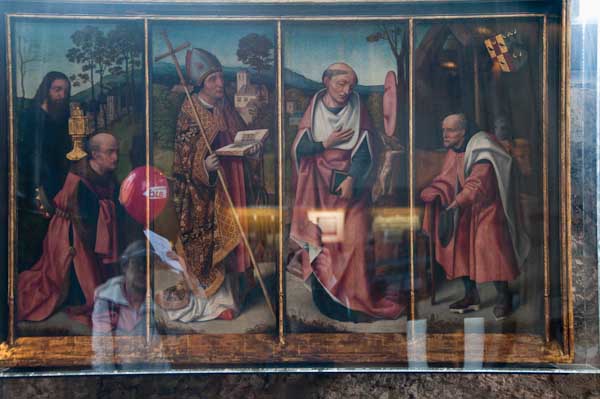
A Christian Aid Balloon in the Tate altarpiece, a Flemish
masterpiece from around 1500 in All Hallows
more pictures
Linda was doing a sponsored walk around City churches for Christian Aid -
as she has for quite a few years. And I went with her to make sure she didn't
get lost! Although I've been in all the churches over the years it's still
interesting to see them again, and there are always things I've not noticed
before - like this kneeling man with his hand holding a red Christian Aid
balloon as Linda looks at the picture. It's really a very fine work of art
even without the balloon, although it could be better displayed. The was originally
a larger centre panel which disappeared. The man holding the balloon is Sir
Robert Tate and it was given to All Hallows by the Tower by Tate & Lyle
- and the third panel is St Jerome with his lion, invisible in my picture
thanks to a reflection, but I don't think much like the one on the syrup tin.
As well as some works of art inside them, the churches themselves are fine
buildings, and there are also some other pictures of London as we made our
way round a circuit which took in two cities (London and Southwark) and around
30 churches. It's a journey that starts and ends with an elephant, includes
a yurt, a knight and a dragon as well as Adam and Eve, would you believe it?
more pictures
Protest Against Executions in Iran
Trafalgar Square & Iranian Embassy, London. Sat 15 May 2010
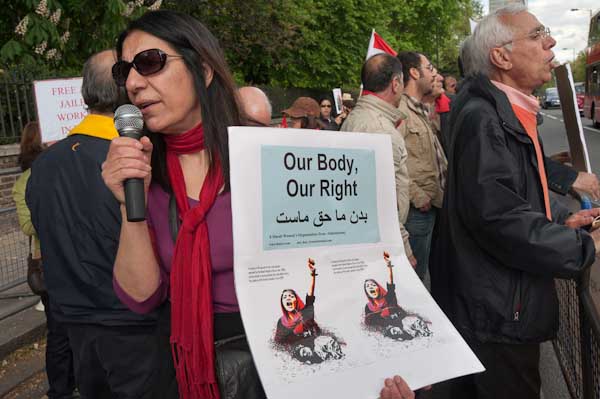
Protesters opposite the Iranian Embassy in Kensington
more pictures
Around a hundred people demonstrated in Trafalgar Square and then marched
for a rally opposite the Iran Embassy following the execution last Sunday
of 5 political activists, the latest of many such death sentences.
Iran Solidarity UK organises regular weekly demonstrations in Trafalgar Square
against the continuing persecution of political activists and in support of
human rights in Iran. They are a part orf an international movement to demonstrate
solidarity with the Iranian people who live under a regime of tyranny.
Since June 2009, millions of Iranians have protested for greater freedom
in Iran, and the protests hit the world headlines when Neda Agha-Soltan was
shot dead during a street demonstration on 20 June 2009. Thousands have been
arrested, tortured to make untrue confessions and then condemned in unfair
trials and many have been executed.
The repression has hit particularly hard in the border areas of Iran where
a large proportion of the population is Kurdish and where most of the mineral
wealth of the country is located. A general strike took place there on Thursday
May 13 closing down most shops and bazaars. Despite the possibly extreme consequences,
many students, workers and others continue to protest and try to rid themselves
of the dictatorship that has been in charge of the country for over 30 years.
Saturday's demonstration was in protest at the executions of five political
activists - four men and a woman - on Sunday 9 May; Farzad Kamangar, Ali Heydarian,
Farhad Vakili, Mehdi Eslamian and Shirin Alam-Houli. Protests have already
taken place in Iran and at Iranian embassies in various cities around the
world against these killings.
The protesters in London called for the media to report on what is happening
on the streets of Iran and for people and organisations across the world to
show their support for the struggle of the people of Iran.
more pictures
Purple Protest Demands Fair Votes
Westminster, London. Saturday 15 May 2010
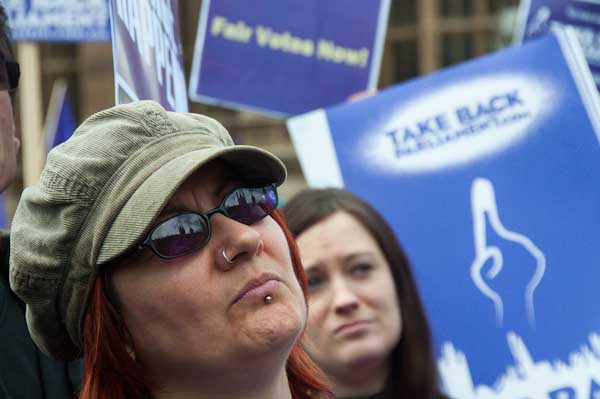
Take Back Parliament - and it is reflected in her glasses
more pictures
More than a thousand people, mainly wearing purple, came to Westminster to
demand a fair voting system, feeling cheated by the recent election results
which failed to produce a government reflecting how people voted.
Old Palace Yard opposite the Houses of Parliament became fairly packed with
people as the rally there called for "fair votes, fair choice" and
demanded an end to the "first past the post system" which the feel
they recent election demonstrated was broken and outdated.
The rally there was one of a dozen or so in towns and cities across the UK,
in a movement that has sprung up rapidly through the Internet, using Twitter,
Facebook, You Tube and other social networking sites, but has also attracted
the backing of existing electoral campaigning groups such as the Electoral
Reform Society, Unlock Democracy (incorporating Charter 88), 38 Degrees and
Power2010.
Speakers from these and other organisations, politicians including MEP Jean
Lambert and Martin Linton, former Labour MP for Battersea, radical comedian
Mark Thomas, environmentalist George Monbiot and others from the Take Back
Parliament movement all spoke to considerable applause from the crowd.
Crowd and speakers were united in finding the current proposals for a referendum
on an alternative vote system failed to go far enough - and felt that they
represented more an attempt to defuse the issue than to deal with it
At the end of the rally the crowd walked across the road and tied purple
ribbons on the fence in front of the House of Commons before continuing to
Downing St where the Take Back Parliament petition was taken into No 10, and
the rally dispersed quietly.
To many mainstream commentators and politicians, the idea of a mass demonstration
in favour of proportional representation came as an utter shock - and some
continue to deride it as just a few extremists who have no popular support.
Seeing it close to, both online and in person, they may well have completely
misjudged the public mood. This really could be the start of a large and growing
popular movement that in the longer term politicians will be unable to ignore.
Proportional representation for the UK parliament may be an idea whose time
has come.
more pictures
South African Right March in London
Trafalgar Square, London. Saturday 15 May 2010
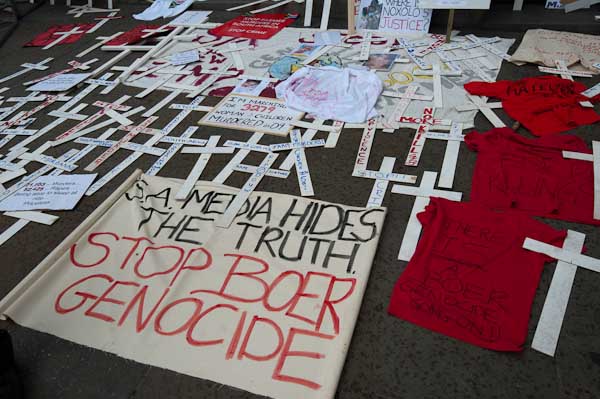
The marchers left this display outside South African
House at the end of the march
more pictures
Unfortunately I arrived too late to see the march by expatriate right-wingers,
part of a campaign linked to persuading football supporters not to go to the
World Cup in South Africa. South Africa is a country with a relatively high
level of violence and around 18,000 murders a year - too many people of all
races are being murdered. But unfortunately the murder and crime rate there
is fairly typical of developing countries, and lower than in many of them.
By the time I arrived at Trafalgar Square there were just a few people in
red shirts and a display of crosses and photographs, which they left to be
taken away by the police.
A message to those wanting to take part in the march regretted that they
were not allowed to bring Afrikaner Weerstandsbeweging (AWB) or other white
nationalist flags (including that of the former Transvaal Republic also used
by the AWB along with their own which resembles the Nazi emblem) to it, or
the Met Police would stop the march. The AWB is an extreme right racist group
whose founder and leader until his recent murder was Eugène Terre'Blanche
and is committed to setting up an independent Volkstaat on parts of South
Africa which they claim under various historical treaties.
more pictures
Nakba Protest For Free Palestine
Downing St, London. Saturday 15 May 2010
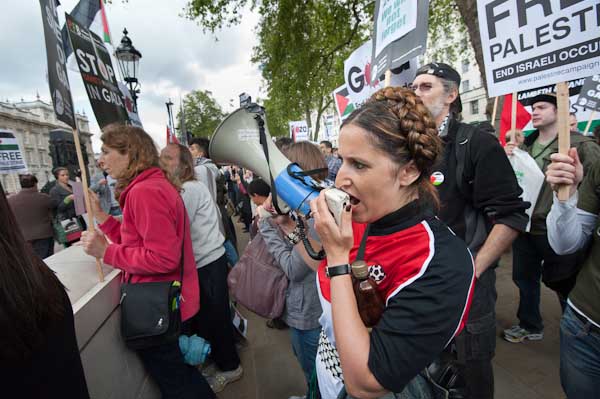
A woman in a Palestine football shirt leads some chanting
more pictures
Several hundred demonstrated opposite Downing St on the anniversary of the
1948 expulsion of Palestinians from their land, calling for an end to Israeli
occupation and breaches of international law. London, UK.
Nakba (catastrophe) is the name given by Palestinians to the destruction
of over 400 Palestinian villages and the creation of around 700,000 Palestinian
refugees in the 1948 partition of Palestine to create the state of Israel.
The annual commemoration is on May 15, the day after the anniversary of Israeli
independence, and demonstrations take place around the world, calling for
justice for Palestine.
The London protest was organised by the Palestine Solidarity Campaign,
British Muslim Initiative, Stop the War Coalition, CND and the
Palestinian Forum in Britain. A few of those taking part told me that
they resented the presence of some political groups that seemed more interested
in promoting their own organisations than the Palestinian cause, but others
pointed out that these groups give a great deal of support to this as well
as many other political causes.
The crowd filled a large section of the penned area on the opposite side
of Whitehall with banners and placards and chanted slogans calling for an
end to the illegal Israeli occupation of Palestinian land and an end to the
seige on Gaza. They called on Israel to stop encouraging and building settlements
on Palestinian land, and to close down existing ones. They also want Israeli
war criminals to be brought to justice, and for international governments
not to try to prevent warrants being served on them.
There were also calls for a boycott of Israeli goods, and for the enforcement
of a ban on the illegal import of those produced on the settlements. The EU
should end its association agreement with Israel and there should be a block
on selling arms to Israel.
The protest took place only days after the Organisation for Economic Cooperation
had voted unanimously to invite Israel to join this group of rich nations,
despite the objection of the Palestinian Authority, whose Foeriegn Minister
had written a letter to the 31 countries stating that to do so would mean
"giving legitimacy to its policies and accepting its aggressive and
racist practices against the Palestinian people" and pointing out
that the restrictions that Israel imposes harm the economic development of
Palestine and are contrary to the free trade principles of the OECD.
Among those demonstrating were a group of ultra-orthodox 'Neturei Karta'
Jews who are opposed to Zionism and refuse to recognize the existence or authority
of the so-called "State of Israel." They claim to be true followers
of the Torah which prohibits the use of human force to establish a Jewish
state before the coming of the Messiah. They support the right of the Palestinians
to their land, which should be returned to them, and would like Jews such
as themselves to be able to live in peace and harmony with their Muslim neighbours
in Palestine as their ancestors did for many centuries.
The Neturei Karta had walked the roughly six miles from Stamford Hill to
take part in the demonstration on the sabbath, and after it would have to
walk back home. The demonstration remained peaceful and at the end of its
scheduled two hours dispersed quietly, with some going on to join other nearby
protests.
more pictures
Kingston Bus
Kingston, London. Friday 14 May 2010
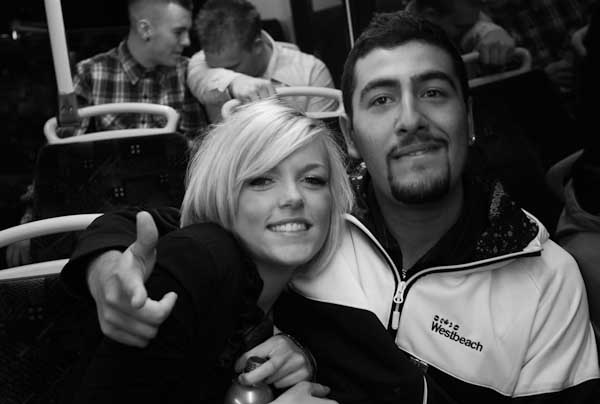
I was on my way home, they were going out for the night
to Kingston
more pictures
I'd had lunch with a couple of photographers and spent the afternoon and
evening talking photography with them (and having a glass or two of wine.)
So when I got on a crowded bus around 10.30pm and found lots of young guys
just going out for the evening clubbing in Kingston I got out the Leica M8
and took a few snaps.
As you know I've found the M8 rather challenged when it comes to colour,
and I've decided it makes a decent black and white camera, but when I want
colour I'll use the Nikon. I should have used a wider aperture than the f5.6
the lens was set on, but if I'd been in a condition to think about things
like that I probably wouldn't havwe been taking pictures anyway! But I this
this is a nice picture, and a couple of others aren't bad.
more pictures
Take Back Parliament - Fair Votes
Palmer St, Westminster, London. Monday 10 May, 2010
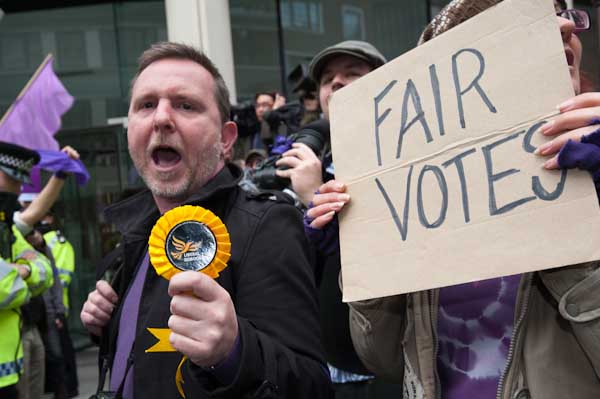
A Liberal Democrat candidate holds up his rosette outside the talks
more pictures
As the political parties engage in horse-trading in closed sessions to argue
about what will emerge from last Thursday's UK General Election, a powerful
grass roots movement is emerging to challenge the cosy political domination
of the major parties and press for an electoral system that puts power back
to the people.
Take Back Parliament is a coalition of different groups
and organisations in the call for fair votes, including POWER2010, Unlock
Democracy, the Electoral Reform Society and Vote for a Change,
and also many individuals who are disgusted at their lack of representation
in the current political carve-up.
Events are developing fast in the negotiations between the Liberal Democrats
and the other parties, and the demonstrations last Saturday, today in at the
weekend appear to be playing a part in ensuring that reform of our political
process stays at the head of the political agenda.
Approaching a thousand people, many wearing purple and some with purple marks
on their faces or index fingers came to Palmer St in Westminster to demonstrate
outside the building where the Liberal Democrats were meeting to discuss the
progress in the negotiations. There they held placards and banners and chanted
demanding a change to a fair voting system that would results in a Parliament
that truly represents the votes of the British people.
Although many have felt for years that our current system was unsatisfactory,
last Thursday's results underlined this, with a party getting only 36% of
the overall vote claiming a mandate to form a government - although they don't
quite have enough parliamentary seats to do so.
The two other main parties between them had 52% of the vote, but combined
only got a few more members of parliament than the Tories, and at first seemed
to be ruled out of the chance of forming a government, although the situation
is currently changing fast, particularly following the decision of Gordon
Brown to step down from the Labour leadership.
Many of us in the UK are now convinced that our political system encourages
and rewards irresponsible political parties and that we need to move towards
a system that works through coalition and agreement rather than the kind of
polarised idiocy that is shown in some aspects of the current party manifestos.
We need politicians who will work together in the national interest and a
system that allows a wide range of views to be represented.
A number of those present also expressed disquiet at the way our present
system - and all three major parties - is dominated by 'men in suits', overwhelmingly
members of a few elite professions and those who have attended a small number
of schools and universities and were calling for a radical change in our whole
political system with the end of a political class and involving politicians
more representative of the population as a whole.
The Take Back Parliament coalition represents not just the organisations
backing it, but a wide movement among the people, many of whom are still incensed
by the actions of politicians over the expenses scandal and for whom the election
results were the last straw. The feelings were certainly reinforced by the
scandal of thousands of would-be voters being denied the chance to vote on
Thursday as polling stations ran out of ballot papers and long queues that
formed in the last couple of hours of voting were not allowed to vote.
The colour purple chosen to stand for the movement is of course the colour
of the suffragettes who fought for the last major change in our voting system
when women were given the vote around 80 years ago - and is also conveniently
not used by any of the major parties. One of the people walking openly into
the Liberal Democrat meeting though the clear pathway left to the entrance
of the building was wearing a purple tie, and several TV presenters have appeared
in them today. But many of those attending the meeting didn't take the clear
path in, but barged their way rudely through the crowd to try and get in without
being seen by the demonstrators, which was perhaps not a good omen.
But despite this, the demonstration remained peaceful and good-natured, although
determined to get their point across. There was a jazz group providing some
fine music in the gaps between chanting and speeches, and among the speakers
was Billy Bragg, whose high-profile campaigning in Dagenham helped
the borough see off the BNP.
Much of the discussion now taking place on the media about our future government
seems not to have caught up on the public mood, being still based entirely
on the number of parliamentary seats won under the now discredited electoral
system. But a significant part of the electorate has moved on, and for them
the most significant aspect are the votes cast - under which a coalition of
any two of the major political parties has a majority.
more pictures
Merrie England and London May Queen Festival
Hayes, Kent. Saturday 8 May 2010
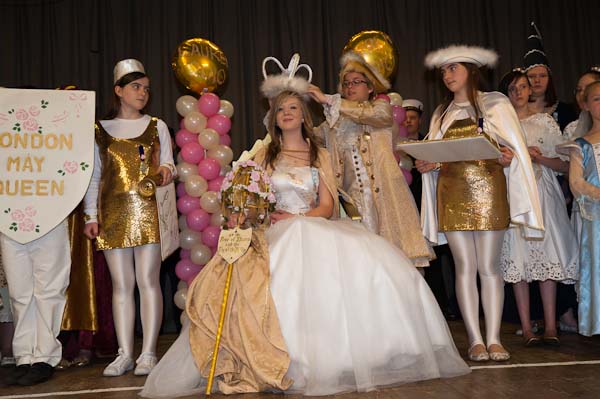
The 2010 London May Queen is crowned
more pictures
The day was cold and wet, and the procession around Hayes had to be abandoned
with the ceremonies taking place in a packed Hayes Village Hall. Although
the queens from the 26 realms around south-east London and Kent were there
for the event, most had only a small group of their attendants as there was
simply not room for everyone.
The ceremonies, first written by Joseph Deedy who founded the Merrie England
Society in 1911, went ahead as normally as possible in the hall. Before they
started, there was a short addition as the Hayes Village May Queen had missed
her crowning ceremony at the end of last month, trapped abroad by the ban
on flights due to volcanic ash. Once she was crowned in a side hall the main
events could continue.
The bagpiper lead a short procession up and down the hall and then the members
of the London May Queen group took the stage, in front of the Sea Cadets.
'Little Sanctum' is a short service usually held outside the parish
church next door to the hall, but this year took place on the stage. After
a short introduction by the curate, the London May Queen made a short speech
and introduced the Joy Bells, each giving thanks for a different gift - Flowers,
Music, Life etc. You can read some of the texts of this
ceremony here,
were there are also pictures of the 2008 May Queen festival, and of the 2005
event here, both in fine weather. This part of the proceedings ended with
prayers by the curate.
Next this year's London May Queen took the throne and there were the traditional
series of short readings - The Month of May, Woodland Call, the Invocation,
The Quest, The Choice and The Challenge - read by various members of the London
May Queen group including the Fairy Queen, Bo-Peep and Robin Hood, before
the Prince of Merrie England crowns the London May Queen who then reads her
Royal Speech.
In the crowded hall I found it hard to hear much of these readings; unfortunately
the public address system had been set up on Hayes Common and the girls were
not used to having to project their voices.The texts have a certain period
charm and give form to the event but its attractions are mainly visual.
Each of the May Queen realms - and there were three more at this year's event
than when I last photographed it - has their own colour and flower, and also
their own ideas about costumes and crowns, with a lot of work being put into
these by mothers and grandmothers, many of whom were May Queens in their day.
It took some time for all of the Queens to individually come up on stage
and be presented to the London May Queen, and then the stage was packed as
all 26 came up together and were photographed. There wasn't any way I could
take a picture that showed everyone at the same time, though I did my best.
Finally there was another procession by members of the London May Queen,
lead by Bo-Peep and then the London May Queen "as Flora" scattered
flowers around the hall. Usually the event ends with dancing around the maypole
on the common, but unfortunately this could not be done in the hall.
I was pleased to have been asked by one of the mothers involved to come and
photograph the event again, and it was good to meet some of those I'd photographed
in previous years. I'm still hoping at some time to produce a book and an
exhibition about May Queens at some time - an exhibition almost happened a
year or so ago but was cancelled at the last minute. 2012 would be an ideal
year for it as it will be the year of the 100th London May Queen.
more pictures
Election Day in Parliament Square
Parliament Square, London. Thursday 6 May 2010
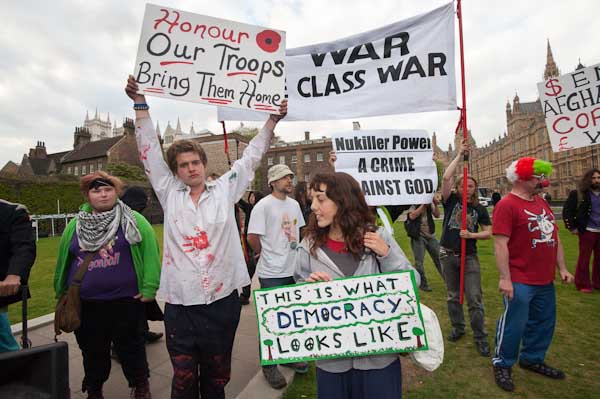
Protesters from the Democracy Camp visit the media village on College Green
more pictures
On Election Day, the Democracy Camp in Parliament Square, which was urging
people to spoil their ballot papers, turned out to be surprisingly controversial
with bitter arguments with long-term peace protester Brian Haw and supporters.
Brian Haw began his peace campaign in Parliament Square 3260 days ago on
2 June 2001, very nearly nine years ago. Over the years he has faced a continous
harassment by police, had an Act of Parliament passed to get rid of him and
faced numerous attacks by individuals, some of whom appear to have had connections
with the police and security services, and from which the police have failed
to protect him.
The most serious attack came on May 23, 2006, when an illegal police raid
involving 78 officers and costing £28,000 took away and destroyed most
of his display, and three of his supporters were arrested. The raid took place
seven days before a court hearing that was due to decide on the whether or
not the conditions imposed on his display were reasonable or not, and happened
despite there being no power under the Act concerned to seize possessions.
In Jan 2007 a judge ruled that the conditions that had been imposed were unlawful,
and in the same month artist Mark Wallinger installed 'State Britain', a complete
replica of his removed display at Tate Britain.
I was present on 12 Jan 2008 at Downing St when Haw was assaulted in an unprovoked
attack by a police officer while filming a demonstration there, and saw him
arrested for protesting at having been assaulted. I was also in Parliament
Square on the evening of 30th October 2009 when police arrested Brian Haw
again, holding him at Belgravia Police Station overnight but was then released
on the order of the court.
In April 2009, Haw dissociated his Parliament Square Peace Campaign (PSPC)
from the 'Peace Strike' protest in the adjoining area of the square led by
Maria Gallestegui "by mutual consent", wanting to end any confusion
between the two campaigns. For reasons that are not clear, the 'Peace Strike'
has been allowed a considerably larger physical presence in the square and
has not been the subject of the same campaign of police harassment as the
PSPC.
The election has increased the pressure on Haw and his small group of supporters
at the PSPC, including Barbara Tucker who has also been in Parliament Square
full-time for some years. David Cameron has gone on record as saying that
he would have cleared out their protest long ago, and a Conservative government
is likely to both increase the pressure on the police to take action and to
have an even blinder eye towards illegal police harassment and further vigilante
action against them. The protesters are particularly worred that action may
be taken in the days leading up to the state opening of Parliament on May
25th, possibly on the anniversary of the 2006 raid, which happened on May
23.
Those in the Democracy camp see themselves as reinforcing the long term protest
by the peace campaign, and hope that their presence there will make it harder
for the incoming government to get rid of the protests in the square.
The PSPC regard the activities of the 'Peace Strike' and of this week's 'Democracy
Camp' organised in conjunction with it as providing a pretext for more draconian
police action against them, and have suggested that some at least of those
involved may well be agent provocateurs in police pay. Several individuals
in the wider anti-capitalist movement have indeed been identified as being
police undercover agents, and evidence showed at least one such person involved
in provoking violent activities during the G20 demonstrations - which were
used to justify violent attacks by riot police on largely peaceful demonstrators.
The Democracy Camp has been in Parliament Square since the May Day demonstration
there last Saturday, and police appear to have taken no action over various
irregularities. Drinking alcohol for example is prohibited in Parliament Square
- and the Democracy Camp has a notice telling people not to do so, but on
both occasions I've visited there were people openly drinking, and the people
from the PSPC have been protesting to the campers about this.
At one point the dispute between the camp and the PSPC deteriorated with
a man on the camp's sound system making what were possibly intended as humorous
put-downs of Barbara Tucker who was then attacking the Tory Party for the
backing it receives from the oil giants. Clearly some of the campers were
distressed by this and he was asked to desist, and some of those present tried
to calm the situation.
But generally the camp's activities were more positive, and while I was there
considerable work was taking place making banners and placards, as well as
people discussing and dancing.
Brian Haw too was continuing his campaign, and gave a spirited rendering
of the poem 'Kabullshit', written this February, one of a number of war related
poems from the Freedomlite site.
Shortly before 6pm, a procession set out from the camp towards the media
village opposite the Houses of Parliament on College Green with these banners.
The TV crews largely looked rather bored and mostly pointedly ignored the
protest but a few did bother to point a camera in their direction.
After a few minutes of music and dancing and some short speeches, the campers
turned around and made their way back to Parliament Square. As they arrived
several police vans drove up, apparently worried that the protesters might
disrupt media coverage of the election. Police stopped and talked to a few
of the campers, and one young man drinking from a can of beer was warned that
it was an offence to drink alcohol in public there.
more pictures
People's Jury Condemns Arms Manufacturer
Victoria St, Westminster. Wednesday 5 May, 2010
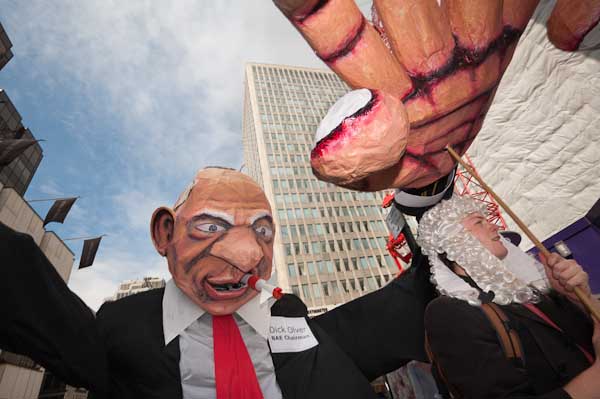
Dick Olver, BAE Chairman with a judge on Victoria St
more pictures
Around 30 Campaign Against Arms Trade protesters, many of them dressed as
Judges in wigs and gowns, carried a 12 foot high effigy of the chairman of
BAE, the world's second largest arms producer to protest outside the BAE Annual
General Meeting taking place in the QEII Conference Centre.
In January the Serious Fraud Office agreed a plea bargain with BAE over the
alleged bribery and corruption the company had been involved with over arms
deals. CAAT decided to set up a 'People's Jury' to try them over this and
other arms dealing crimes.
They began their protest outside the Victoria St offices of the government's
arms sales department, and after a few short messages and handing out leaflets
there, chased the giant puppet Dick Olver (Chairman of BAE Systems plc since
2004) down the street to the Queen Elizabeth II conference centre where BAE
was holding its Annual General Meeting, with cries of "BAE can’t
you see: corruption is your legacy".
Outside the QEII centre, the people's jury gave it's unanimous 'GUILTY' verdict.
At the short trial, various people gave evidence alleging that BAE were guilty
of corruption, selling weapons to oppressive regimes, perversely influecning
university reseach programmes, misleading the British public over its commitment
to British jobs, the undermining of South Africa's democracy, stealing from
the Tanzanian people and support of the DSEi arms fair in East London.
According to CAAT the company's recent focus has been specifically on the
supply of arms to the US for use in Iraq and Afghanistan. Other exports include
Eurofighters to the Saudi regime, systems for Israeli fighter aircraft and
sales to both India and Pakistan
Inside the BAE AGM, CAAT supporters were also asking questions about the
companies activities, which Chairman Dick Olver failed to answer, brushing
off charges of corruption and a call to resign, claiming that BAE could be
relied upon to police themselves, despite the past evidence to the contrary.
more pictures
Ridgeway Walk
Tring, Aldbury and Ivinghoe Beacon. Monday 3 May
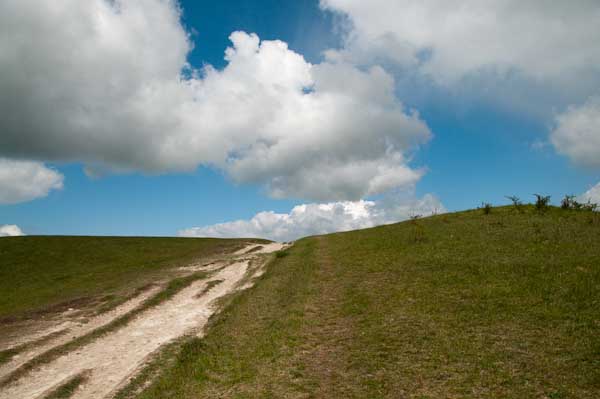 The
track up Ivinghoe Beacon
The
track up Ivinghoe Beacon
more pictures
It was a Bank Holiday, so we went for a walk in the country, taking the train
to Tring. The journey was slightly enlivened by our station selling us tickets
via Kensington Olympia, as that line was closed for engineering works (though
not according to the online enquiry service we accessed by mobile phone.)
We had to do a lot of showing tickets to people at barriers on the underground
and at Euston that weren't valid for travel on that route.
But the walk was fine, though despite the blue sky there was a biting wind
up on the Ridgeway, and too many steps to climb up on the monument near Aldbury,
where the May festival was unfortunately just coming to an end by the time
we got there.
more pictures
Rave Against The Machine
Leake St, Waterloo, London.
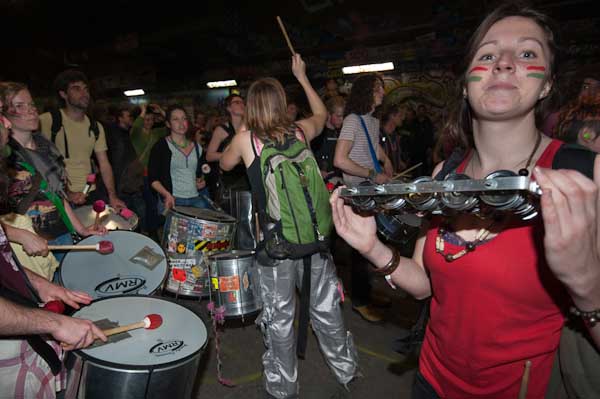 more
pictures
more
pictures
Street band 'Rhythms of Resistance' kicked off the May Day 'Rave Against
The Machine' street rave in Leake St, under Waterloo Station with some powerful
samba drumming.
After appearing at the May Day Mutiny Carnival in Parliament Square, the
street band made its way across Waterloo Bridge with a police escort. I was
held up photographing the carnival and only caught up with it as it came into
Leake Street, an street width underground tunnel that runs under the 22 platform
tracks of Waterloo station. The event had been due to start at 4pm, but everthing
was running around 25 minutes late as the Black Horse procession coming from
Clerkenwell had been held up.
Leake Street is best known as one of London's major venues for graffiti,
and in its time has had pieces by many of the UK's best-known artists. Although
I recognised some of the work from my previous visits, I think some of the
more interesting painting had gone, but it was still colourful and made an
ideal setting for a rave. The arched brick roof above the street throws the
sound back down and the samba drumming was impressive indeed.
The street is entirely under cover, which was just as well, as the sky had
for some time been a deep threatening black and a few drops of rain were falling
as we entered the tunnel, and by the time I left to catch my train around
20 minutes later a torrential hail-storm was starting.
Rave Against the Machine was advertised as a way to get away from the election,
'street soundclash' with the strap-line 'Reclaim the Streets! F**k the Election!'
but although it was almost certainly technically an illegal event it was probably
causing little or no inconvenience or annoyance as Leake St is fairly isolated
and also rather well insulated by the station above. And unlike the 1990s
'Reclaim the Streets' protests on busy roads and motorways it would not disrupt
traffic, as apart from the graffiti artists it is only used by the occasional
pedestrian as a short cut to Lower March. The only connection with the earlier
movement is really the use of the name.
more pictures
Spoil Your Vote Campaign Bus
Westminster, London. Saturday 1 May 2010
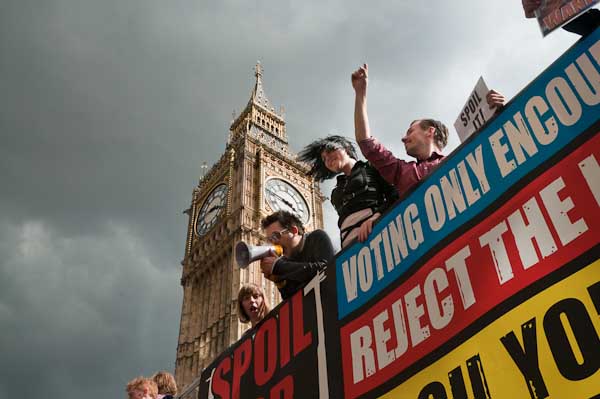 The
bus passing the Houses of Parliament
The
bus passing the Houses of Parliament
more pictures
The Space Hijackers, noted for their challenging political interventions
today drove around London in their General Election Battle Bus urging people
to "reject the lot of 'em and spoil your ballot".
The 'Spoil Your Ballot Battle Bus' left Limehouse to tour London at 1pm,
but its progress around the city was slowed by various events including the
May Day march which had brought the city close to gridlock, with traffic on
many major streets slower than walking pace. It was a quarter to four before
the red open-topped vehicle, its upper deck full of Space Hijacker 'agents'
waving and shouting at the crowds on the pavement drove slowly past the Houses
of Parliament. Some held up the series of four 'Class War' produced posters
with large head and shoulders portraits of Brown, Cameron, Clegg and Griffin
each with a simple one-word slogan - 'W*NKER', while others on the lower deck
were at the rather small opening windows handing out leaflets.
The Space Hijackers message was clearly spelt out in large banners on both
sides of the bus, Spoil For Choice, Voting Only Encourages Them, Reject The
Lot Of 'Em!, Spoil Your Ballot. On their web site they say:
"If voting actually changed anything they would ban it. Did you get to
vote on the Iraq war? Did you get to vote about regulations on banking? Did
you get to vote on MP's expenses? Is this a democracy or a bad joke?
Why play by the rules in this farce of an election?
Every spoilt ballot gets counted and shown to the candidates in that constituency,
so why not reject the lot of them and tell them what you think with your ballot
paper?"
Many find it hard not to at least sympathize with their views, with a Labour
party that has clearly abandoned its socialist ideas and lost the ability
to govern, a conservative party that clearly denies both its traditions and
its policies by promising change and the liberal democrats who are still unable
to overcome the obstacles put in their way by an unfair electoral system.
Locally I attended the so-called "hustings", a tame election meeting
modelled on the TV debates and felt that it made a very good argument for
having a "none of the above is suitable" box on the ballot paper.
We do actually have a "Best of a Bad Lot" candidate among the several
independents also standing but he seems even less convincing.
I've met and photographed all three main party leaders and many other politicians,
and there are among them quite a few I admire across various parties but none
of whom are ever likely to become prime minister. Being thoughtful, sensible,
honest and straightforward is seldom if ever a way to be successful in our
current political system. It really is time for a change and along with many
voters my conclusion is not that one shouldn't vote, but that a parliament
in which no party has an overall majority is our only hope of getting it.
more pictures
May Day Election Carnival
Westminster & Parliament Square. Saturday 1 May 2010
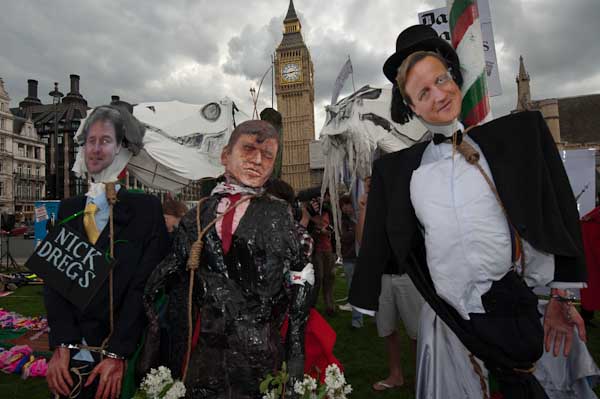
The three main party leaders and Big Ben
more pictures
Protesters against Parliament and the political parties converged on Parliament
Square on May Day afternoon to execute effigies of George Brown, David Cameron,
Nick Clegg and Nick Griffin and hold a May Day Party.
Four processions made their way to Parliament Square, each led by one of
the 'Four Horses of the Apocalypse' following the pattern of last year's demonstration
at Bank on April 1st. This year however the demonstrators were not "kettled"
or attacked by police and although involving the same groups of demonstrators
it was - as intended last year - an afternoon of carnival and street theatre.
The Black Horse of Anarchy had come all the way from Clerkenwell with the
trade union and socialist march to Trafalgar Square, but the other three Horses
had made shorter journeys from the Westminster campaign headquarters of the
three political parties, bringing with them effigies of Gordon Brown, David
Cameron and Nick Clegg.
Amid considerable glee, David Cameron and Nick Clegg were hung from a specially
erected gibbet and Gordon Brown beheaded rather gorily and then disembowelled.
Nick Griffin was simply thrown to the mob who rapidly tore him to pieces.
A samba band from Rhythms of Resistance played and people danced on the street
in front of Parliament and a colourful dragon danced around the square while
a large maypole was erected. A few people climbed up on the statues of Churchill
and Lloyd George and stuck stickers or draped banners on them, and a couple
of people climbed up a tree and staged a nude protest with a peace flag.
The weather too provided considerable drama, with bright sun in the square
and on the Houses of Parliament but some of the darkest black clouds I've
seen behind them - and later, as I was going home there was a hailstorm.
But before that there was time for some more partying, and for a maypole
dance in which both the executioner and a mermaid took part. I narrowly escaped
being bound to the pole by the ribbons as they danced around.
more pictures
Trade Union & Socialist May Day March
Clerkenwell Green. Saturday 1 May 2010
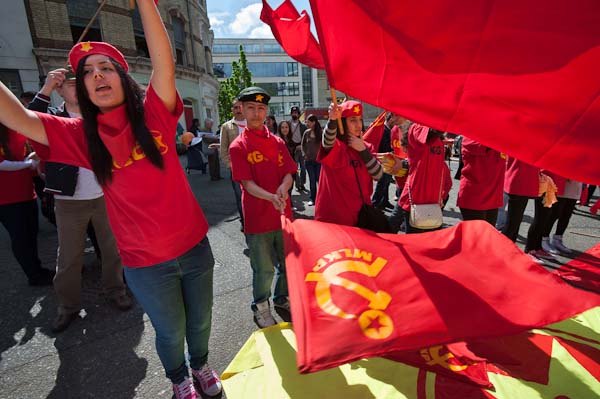 Turkish communists put on their usual display in the march
Turkish communists put on their usual display in the march
more pictures
Thousands of trade unionists, socialists, communists and others came together
to celebrate May Day, internationally recognised as a worker's day, with a
march from Clerkenwell Green to a rally at Trafalgar Square.
The now traditional May Day march in London from Clerkenwell Green to Trafalgar
Square was as usual dominated by Turkish groups, with Kurds. Iranians, Latin
Americans and others representing refugee and migrant groups in London also
taking part behind a main banner calling for 'Trade Union Rights, Human Rights
and International Solidarity.'
There were a bewildering number of socialist groups including many that I've
photographed before, including the International Union of Sex Workers, the
National Pensioners Convention and Gate Gourmet Strikers. It always surprises
me to find that a number of groups still seem to include Stalin in their pantheon
of communist leaders alongside Marx, Engels, Lenin and Mao.
One of the banners was carried by two Turkish women with tabards - one in
English reading 'Stop the Deaths' and the banner was covered with over 120
named portraits under the heading 'Heroes Do Not Die The People Are Not Defeated.'
Towards the rear of the procession of several thousand people were several
groups of anti-capitalists and anarchists, mainly in black and many wearing
face masks (and despite this some were not happy to be photographed.) Along
with them was the 'Black Horse of Anarchy', one of the four horses of the
Apocalypse on its way to the Mayday election carnival in Parliament Square,
accompanied by an executioner with a large plastic axe and a shopping trolley
containing a dummy with a rather small head and the face of Nick Griffin.
May 1 was first established as an International Worker's Day by the Communist
Second International in the 1880s, in commemoration of the killing of strikers
in the 1886 Chicago General Strike. It is celebrated in many countries around
the world, and is in some known as Labour Day. As a cold war gesture, the
USA in 1958 re-designated May 1 as Loyalty Day, and Labor Day is celebrated
there on the first Monday in September.
The march ended at Trafalgar Square where there was a trade union rally,
but many of the marchers went elsewhere, and so did I.
more pictures
top of page
All pictures on this section of the site are Copyright ©
Peter Marshall 2010; to buy prints or for permission to reproduce pictures
or to comment on this site, or for any other questions, contact
me.

















 The
track up Ivinghoe Beacon
The
track up Ivinghoe Beacon 
 The
bus passing the Houses of Parliament
The
bus passing the Houses of Parliament
